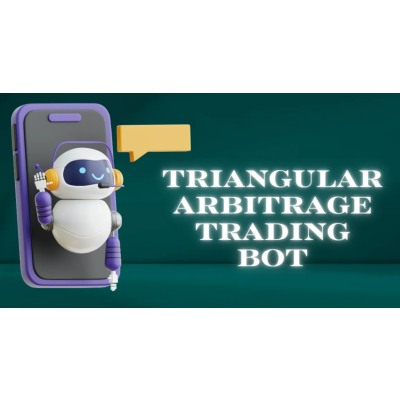

2024, navigating the complexities of cryptocurrency trading demands cutting-edge tools and strategies. Enter the ultimate guide to Triangular Arbitrage Trading Bots, designed to empower traders with advanced automation capabilities. This comprehensive resource delves into the intricacies of triangular arbitrage, a technique leveraging price discrepancies across multiple currency pairs to generate profit. Explore the fundamental principles that underpin this strategy, from identifying arbitrage opportunities to implementing automated trading algorithms effectively.

Discover how these bots execute rapid, simultaneous trades to capitalize on fleeting market differentials, optimizing trading outcomes with precision. The guide also addresses key considerations such as risk management techniques and technological requirements, essential for deploying robust trading systems. Whether you’re a seasoned trader or new to the world of automated crypto trading, this guide equips you with the knowledge and tools necessary to navigate and thrive in the dynamic landscape of cryptocurrency markets in 2024.
A Triangular Arbitrage Trading Bot is a sophisticated software tool designed to automate the execution of triangular arbitrage strategies in cryptocurrency markets. Triangular arbitrage exploits price discrepancies between three different currency pairs to generate profit. The bot continuously monitors exchange rates across these pairs and identifies instances where the combined exchange rates create a profit opportunity through arbitrage. By swiftly executing buy and sell orders across the three currencies in the optimal sequence, the bot capitalizes on fleeting price differentials that human traders might miss or execute too slowly.
This automation not only enhances trading efficiency but also reduces the impact of human emotions and delays in decision-making. Advanced bots may incorporate features such as real-time market analysis, risk management protocols, and customizable trading parameters to adapt to varying market conditions. As a result, Triangular Arbitrage Trading Bots are highly prized by traders seeking to leverage arbitrage opportunities swiftly and effectively in the fast-paced world of cryptocurrency trading.
A Triangular Arbitrage Trading Bot operates based on exploiting price discrepancies among three different cryptocurrencies on multiple exchanges. Here’s how it typically works:
➥ Identifying Opportunities: The bot continuously monitors prices of three cryptocurrencies (say BTC, ETH, and LTC) across different exchanges.
➥ Calculating Arbitrage Opportunity: When the bot detects a price imbalance where the exchange rates between these cryptocurrencies on different pairs don’t align perfectly (e.g., BTC/ETH, ETH/LTC, LTC/BTC), it identifies a potential arbitrage opportunity.
➥ Executing Trades: The bot swiftly executes a series of trades across these three pairs to exploit the price differences. For instance:
This process should ideally result in a profit due to the price differences.
➥ Risk Management: To manage risks, the bot considers transaction fees, withdrawal fees, and the time required for transactions to confirm. It ensures that potential profits outweigh these costs.
➥ Automation and Speed: Speed is crucial in arbitrage trading, so the bot automates the entire process to capitalize on fleeting price differentials before they normalize.
➥ Monitoring and Adjusting: The bot continuously monitors the market and adjusts its strategies based on real-time data to maximize profitability and minimize risks.
➥ Legal and Regulatory Compliance: Depending on the jurisdictions and exchanges involved, the bot must adhere to legal and regulatory frameworks to avoid issues related to market manipulation or non-compliance.
Implementing such a bot requires robust programming skills, an understanding of cryptocurrency exchanges, and real-time data feeds to execute trades effectively.
A Triangular Arbitrage Bot typically includes several key features to effectively identify and capitalize on arbitrage opportunities in the cryptocurrency market:
These features collectively enable Triangular Arbitrage Bots to operate efficiently in the dynamic cryptocurrency market, leveraging price differentials across exchanges to generate potential profits through automated trading strategies.
To build a Triangular Arbitrage Trading Bot, you’ll need to follow a structured approach. Here’s a comprehensive guide you can use for 2024:
Triangular arbitrage exploits price discrepancies among three currencies in the foreign exchange market to profit from market inefficiencies.
Select a suitable programming language (e.g., Python) and framework (e.g., CCXT for cryptocurrency exchanges) for bot development.
Integrate APIs from multiple cryptocurrency exchanges that support the currencies involved in the arbitrage.
Implement logic to fetch real-time exchange rates for the currency pairs involved in triangular arbitrage.
Write algorithms to calculate potential arbitrage opportunities based on the fetched exchange rates.
Develop risk management strategies to handle potential risks such as slippage, transaction fees, and market volatility.
Program the bot to execute trades automatically when profitable arbitrage opportunities are identified.
Set up monitoring and logging mechanisms to track bot performance, executed trades, and potential issues.
Conduct thorough testing in a simulated environment to refine trading strategies and optimize bot performance.
Deploy the bot on a cloud server or local machine with continuous monitoring and updates.
Ensure compliance with relevant regulations and legal considerations in your jurisdiction, especially concerning automated trading.
Regularly update and improve the bot based on market conditions and performance metrics.
By following this guide, you can develop a robust Triangular Arbitrage Trading Bot tailored for 2024.
Effective risk management is crucial when deploying a Triangular Arbitrage Trading Bot in 2024. Despite its potential for profit, arbitrage trading carries inherent risks, such as execution delays, exchange failures, and sudden market volatility. To mitigate these risks, robust risk management strategies must be integrated into bot operations. This includes setting predefined profit margins and stop-loss limits to control trade outcomes automatically.
Additionally, the bot should be equipped with fail-safe mechanisms to suspend operations during extreme market conditions or technical malfunctions. Diversifying arbitrage opportunities across multiple exchanges can also mitigate platform-specific risks. Regular monitoring and analysis of bot performance, coupled with continuous refinement of trading algorithms based on historical data and market trends, are essential.
By prioritizing risk management and adopting proactive measures, traders can maximize the benefits of their Triangular Arbitrage Trading Bot while safeguarding against potential losses in the dynamic and sometimes unpredictable cryptocurrency markets of 2024.
There are several trends and innovations are shaping the future of trading bots, including Triangular Arbitrage bots:
These trends indicate a dynamic future for trading bots, emphasizing innovation, integration with emerging technologies, and adaptation to regulatory landscapes. As technology evolves, trading bots are expected to play an increasingly pivotal role in financial markets, offering efficiency, speed, and enhanced decision-making capabilities to traders and investors.